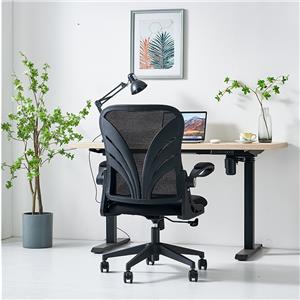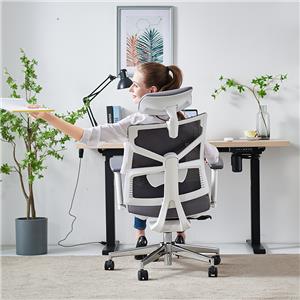How to work comfortably? Start with choosing a good office chair?
Are you sitting comfortably now? OK, I'll wait a few seconds so you can adjust your posture.
Even though we all know our backs should be upright, shoulders back, and hips against the back of the chair, when we aren't paying attention, we tend to let our bodies slide on the chair until our spine takes the shape of a big question mark . This can lead to various posture and circulation problems, chronic pain, and increased fatigue after a day, week, month or years of work. But know that you're not alone, and it's not (necessarily) your fault. What elements make a chair comfortable? How can they help you maintain correct posture for longer? Is it possible to have design and comfort in the same product?
The Covid-19 pandemic has reinforced existing (but not always used) business trends, and this includes companies allowing their employees to work from home. While some people already have a dedicated work space at home with a good desk and chair, this is not the norm for most. The vast majority had to improvise at home, sitting on a living room table, on the sofa, or even in bed.
What we thought would last 2 weeks has dragged on for almost 2 years and complaints of back pain have become more frequent than ever. Proper seating has a direct impact on comfort and productivity, and seating is where most people spend about a third of their day at home or in the office.
The goal of ergonomics (the study of designing equipment and devices to fit the human body and its movements) is to reduce stress and eliminate injuries and illnesses related to muscle overuse, poor posture, and repetitive motion. This can be applied to a range of items from office tools to office chairs.
Although a chair's design may appear simple, there are many angles, sizes, and small adjustments that can make a huge difference in user comfort. That's why choosing the right chair for a home office isn't an easy task: it has to support your needs, not be too expensive, and (at least minimally) match the rest of the space, which requires a lot of research. To be considered a good chair, it should meet a few simple requirements:
Adjustments: seat height, backrest inclination and lumbar support to accommodate different body sizes and types. This allows users to customize the chair to their body and posture, reducing the risk of musculoskeletal disorders and promoting comfort.
Comfort: Usually depends on material, padding and adjustments mentioned above.
Durability: We spent a lot of time in these chairs, so it was important that the investment made was worth it the entire time.
Design: The design of the chair should be pleasing to the eye and match the aesthetics of the room or office.
Based on Ivyco's catalog, we've selected some features that embody the chair's most customizable settings. Of course, the more customizable a project is, the more likely it is to meet your needs exactly. However, when it is not possible to choose the most complete option, you can choose the settings that are most important to you:
Seat: height, depth and recline adjustment
This is an important aspect of chair comfort and ergonomics. Ideally, the height should be adjustable, allowing the user to place their feet on the floor; the depth and width should be sufficient to accommodate different body types. Other important factors are the angle of the seat, which should support the natural curve of the spine, as well as the characteristics of the material and the level of padding, which all affect comfort.
Backrest: height and inclination adjustment
The backrest provides lumbar support and promotes good sitting posture. Ideally it should be sized enough to support the shoulders, neck and back, with adjustable tilt to best support the natural curves of the spine.
Lumbar support: fixed or with height and depth adjustment
It is essential to reduce lower back pain. This should be firm, not too stiff or uncomfortable, and adjustable (angle and height) to accommodate all body types. To promote good posture for long periods of time, this is one of the most important aspects of a chair.
Armrests: Height, Side, Front and Slope Adjustments
They provide a place to relax the arms, help relieve tension in the neck, shoulders, and wrists, and make the chair more comfortable for long periods of sitting.
Headrest: fixed or adjustable
Headrests can be an interesting feature for those who spend long periods of time sitting. It reduces tension in the shoulders and neck. Ideally, it should be adjustable to accommodate different heights, as well as stable and comfortable.
Of course, users must learn to adjust their chair, as well as surrounding objects, so that their working position is as suitable as possible. It is also important to take regular breaks and to stretch, move and adjust posture and position frequently. No doubt, being aware of these points will have a huge impact in the future.




